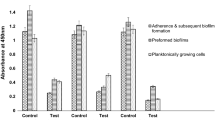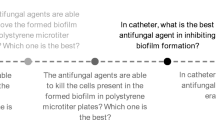Abstract
Candida invasive infections have increased in frequency during the last decades. Such infections are often associated to medical indwelling devices like central venous catheter. The recurrent nature and difficulties in the treatment of these infections are often related to biofilm formation. The objective of this study was to investigate the anti-biofilm activity of low-molecular weight chitosan hydrogel (LMWCH), a natural biopolymer obtained from the N-deacylation of crustacean chitin, upon clinical relevant Candida species. The in vitro ability of LMWCH to impair biofilm formation and to disorganize a preformed biofilm was tested in polystyrene microplates and quantified by the semi quantitative XTT assay and by the crystal violet assay. LMWCH in vivo efficacy as a coating for medical indwelling devices was evaluated for the first time for Candida parapsilosis, using a mouse subcutaneous foreign body model using polyurethane catheter segments. Scanning electron microscopy was used to access biofilm architecture after LMWCH treatment. We found that LMWCH efficiently impaired biofilm formation of all Candida species, also promoting biofilm disaggregation. Most importantly, LMWCH was able to significantly inhibit biofilm formation by C. parapsilosis in an in vivo catheter mouse model. SEM images showed biofilm collapsed cells compatible with membrane damage, suggesting that this could be one of the possible mechanisms underlying biofilm impairment. LMWCH revealed to be a promising compound for treatment of candidiasis or its prevention through medical device coating.



Similar content being viewed by others
References
Douglas LJ (2003) Candida biofilms and their role in infection. Trends Microbiol 11(1):30–36
Estivill D, Arias A, Torres-Lana A, Carrillo-Munoz AJ, Arevalo MP (2011) Biofilm formation by five species of Candida on three clinical materials. J Microbiol Methods 86(2):238–242. doi:10.1016/j.mimet.2011.05.019
Shahidi F, Abuzaytoun R (2005) Chitin, chitosan, and co-products: chemistry, production, applications, and health effects. Adv Food Nutr Res 49:93–135. doi:10.1016/S1043-4526(05)49003-8
Rinaudo M (2006) Chitin and chitosan: properties and applications. Prog Polym Sci 31(7):603–632. doi:10.1016/j.progpolymsci.2006.06.001
Dai T, Tanaka M, Huang YY, Hamblin MR (2011) Chitosan preparations for wounds and burns: antimicrobial and wound-healing effects. Expert Rev Anti-infect Ther 9(7):857–879. doi:10.1586/eri.11.59
Kong M, Chen XG, Xing K, Park HJ (2010) Antimicrobial properties of chitosan and mode of action: a state of the art review. Int J Food Microbiol 144(1):51–63. doi:10.1016/j.ijfoodmicro.2010.09.012
Smelcerovic A, Knezevic-Jugovic Z, Petronijevic Z (2008) Microbial polysaccharides and their derivatives as current and prospective pharmaceuticals. Curr Pharm Des 14(29):3168–3195
Rabea EI, Badawy ME, Stevens CV, Smagghe G, Steurbaut W (2003) Chitosan as antimicrobial agent: applications and mode of action. Biomacromolecules 4(6):1457–1465. doi:10.1021/bm034130m
Raafat D, von Bargen K, Haas A, Sahl HG (2008) Insights into the mode of action of chitosan as an antibacterial compound. Appl Environ Microbiol 74(12):3764–3773. doi:10.1128/Aem.00453-08
Alburquenque C, Bucarey SA, Neira-Carrillo A, Urzua B, Hermosilla G, Tapia CV (2010) Antifungal activity of low molecular weight chitosan against clinical isolates of Candida spp. Med Mycol 48(8):1018–1023. doi:10.3109/13693786.2010.486412
Park Y, Kim MH, Park SC, Cheong H, Jang MK, Nah JW, Hahm KS (2008) Investigation of the antifungal activity and mechanism of action of LMWS-chitosan. J Microbiol Biotechnol 18(10):1729–1734
Palmeira-de-Oliveira A, Ribeiro MP, Palmeira-de-Oliveira R, Gaspar C, Costa-de-Oliveira S, Correia IJ, Pina Vaz C, Martinez-de-Oliveira J, Queiroz JA, Rodrigues AG (2010) Anti-Candida activity of a chitosan hydrogel: mechanism of action and cytotoxicity profile. Gynecol Obstet Invest 70(4):322–327. doi:10.1159/000314023
Martinez LR, Mihu MR, Han G, Frases S, Cordero RJ, Casadevall A, Friedman AJ, Friedman JM, Nosanchuk JD (2010) The use of chitosan to damage Cryptococcus neoformans biofilms. Biomaterials 31(4):669–679. doi:10.1016/j.biomaterials.2009.09.087
Pasquantonio G, Greco C, Prenna M, Ripa C, Vitali LA, Petrelli D, Di Luca MC, Ripa S (2008) Antibacterial activity and anti-biofilm effect of chitosan against strains of Streptococcus mutans isolated in dental plaque. Int J Immunopathol Pharmacol 21(4):993–997
Verkaik MJ, Busscher HJ, Jager D, Slomp AM, Abbas F, van der Mei HC (2011) Efficacy of natural antimicrobials in toothpaste formulations against oral biofilms in vitro. J Dent 39(3):218–224. doi:10.1016/j.jdent.2010.12.007
Bae K, Jun EJ, Lee SM, Paik DI, Kim JB (2006) Effect of water-soluble reduced chitosan on Streptococcus mutans, plaque regrowth and biofilm vitality. Clin Oral Invest 10(2):102–107. doi:10.1007/s00784-006-0038-3
Cobrado L, Azevedo MM, Silva-Dias A, Ramos JP, Pina-Vaz C, Rodrigues AG (2012) Cerium, chitosan and hamamelitannin as novel biofilm inhibitors? J Antimicrob Chemother 67(5):1159–1162. doi:10.1093/jac/dks007
Knowles J, Roller S (2001) Efficacy of chitosan, carvacrol, and a hydrogen peroxide-based biocide against foodborne microorganisms in suspension and adhered to stainless steel. J Food Prot 64(10):1542–1548
Carlson RP, Taffs R, Davison WM, Stewart PS (2008) Anti-biofilm properties of chitosan-coated surfaces. J Biomater Sci Polym Ed 19(8):1035–1046. doi:10.1163/156856208784909372
Clinical Laboratory Standards Institute (CLSI) (2008) Reference method for broth dilution antifungal susceptibility testing of yeasts. Approved standard M27-A3, vol 3, 3rd edn. CLSI, Wayne
Canton E, Peman J, Viudes A, Quindos G, Gobernado M, Espinel-Ingroff A (2003) Minimum fungicidal concentrations of amphotericin B for bloodstream Candida species. Diagn Microbiol Infect Dis 45(3):203–206
Pierce CG, Uppuluri P, Tristan AR, Wormley FL Jr, Mowat E, Ramage G, Lopez-Ribot JL (2008) A simple and reproducible 96-well plate-based method for the formation of fungal biofilms and its application to antifungal susceptibility testing. Nat Protoc 3(9):1494–1500. doi:10.1038/nport.2008.141
Peeters E, Nelis HJ, Coenye T (2008) Comparison of multiple methods for quantification of microbial biofilms grown in microtiter plates. J Microbiol Methods 72(2):157–165. doi:10.1016/j.mimet.2007.11.010
Rupp ME, Ulphani JS, Fey PD, Bartscht K, Mack D (1999) Characterization of the importance of polysaccharide intercellular adhesin/hemagglutinin of Staphylococcus epidermidis in the pathogenesis of biomaterial-based infection in a mouse foreign body infection model. Infect Immun 67(5):2627–2632
Uppuluri P, Chaturvedi AK, Srinivasan A, Banerjee M, Ramasubramaniam AK, Kohler JR, Kadosh D, Lopez-Ribot JL (2010) Dispersion as an important step in the Candida albicans biofilm developmental cycle. PLoS Pathog 6(3):e1000828. doi:10.1371/journal.ppat.1000828
Cobrado L, Silva-Dias A, Azevedo MM, Pina-Vaz C, Rodrigues AG (2012) In vivo antibiofilm effect of cerium, chitosan and hamamelitannin against usual agents of catheter-related bloodstream infections. J Antimicrob Chemother. doi:10.1093/jac/dks376
Palmeira-de-Oliveira A, Passarinha LA, Gaspar C, Palmeira-de-Oliveira R, Sarmento B, Martinez-de-Oliveira J, Pina-Vaz C, Rodrigues AG, Queiroz JA (2011) The relationship between Candida species charge density and chitosan activity evaluated by ion-exchange chromatography. J Chromatogr B: Anal Technol Biomed Life Sci 879(31):3749–3751. doi:10.1016/j.jchromb.2011.07.034
Martinez LR, Mihu MR, Tar M, Cordero RJ, Han G, Friedman AJ, Friedman JM, Nosanchuk JD (2010) Demonstration of antibiofilm and antifungal efficacy of chitosan against candidal biofilms, using an in vivo central venous catheter model. J Infect Dis 201(9):1436–1440. doi:10.1086/651558
Silva S, Negri M, Henriques M, Oliveira R, Williams DW, Azeredo J (2011) Adherence and biofilm formation of non-Candida albicans Candida species. Trends Microbiol 19(5):241–247. doi:10.1016/j.tim.2011.02.003
Al-Fattani MA, Douglas LJ (2006) Biofilm matrix of Candida albicans and Candida tropicalis: chemical composition and role in drug resistance. J Med Microbiol 55(Pt 8):999–1008. doi:10.1099/jmm.0.46569-0
Acknowledgments
We are grateful to Dr. Daniela Silva from Materials Center of the University of Porto (CEMUP), for the helpful assistance with the scanning electron microscopy. We are also grateful to “Fundação para a Ciência e Tecnologia (FCT)” for financial support. This work was supported by the project: “QUITORAL: Desenvolvimento de novas formulações de quitosanos com aplicação em medicina oral”—QREN—ADI 3474, financed by “European Regional Development Fund (ERDF)”. This work was also supported by “Fundação para a Ciência e Tecnologia (FCT)”, by Ph.D. Grant [SFRH/BD/44896/2008 to ASD]. IMM is supported by FCT Ciência 2008 and cofinanced by the European Social Fund.
Conflict of interest
The authors declare that they have no conflict of interest.
Ethical standard
Animal studies were approved by Direcção-Geral de Alimentação e Veterinária (DGAV), the Portuguese National Authority for Animal Health.
Author information
Authors and Affiliations
Corresponding author
Rights and permissions
About this article
Cite this article
Silva-Dias, A., Palmeira-de-Oliveira, A., Miranda, I.M. et al. Anti-biofilm activity of low-molecular weight chitosan hydrogel against Candida species. Med Microbiol Immunol 203, 25–33 (2014). https://doi.org/10.1007/s00430-013-0311-4
Received:
Accepted:
Published:
Issue Date:
DOI: https://doi.org/10.1007/s00430-013-0311-4




